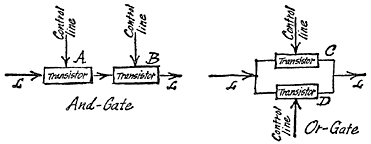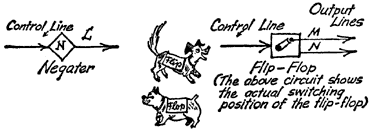The Transistor Age
At this point you might care to rest a while and take a deep breath. For we have just crossed the frontier from theory into practice. Electronic computers might be built from the relay switches we have just described. Not only might they be built - they have been built. Such relays were used in the very first electronic computers, and they calculated correctly - if somewhat slowly. The electromagnets do not need much time to actuate the switches, but the number of switching processes needed made the tenths of seconds add up to minutes and hours.
So a search was made for switches that do not work mechanically at all. They were found in radio vacuum tubes, which function by purely electronic means.
We hope you will forgive our skipping the Vacuum Tube Age altogether (as far as the building of computers is concerned, it is practically over) and turn at once to the transistors. We have mentioned these miraculous little crystals before; we said that transistors can do everything radio tubes can do, and at the same time they are much smaller and consume far less current.
A relay needs about a tenth of a second to make a switchover. If great efforts are made, this time can perhaps be brought down to a fiftieth of a second. That is a stretch of time in which you can hardly hear it click. Nevertheless, it is a very long time compared with the switchover time of transistors. Their working time is only measurable with minor conjuring tricks in physics. It is in the region of nano-seconds: thousand-millionths of a second. No one can imagine how quickly a thousand-millionth of a second passes; we have mentioned it only to impress you.
A transistor can switch so quickly because it works with splendid simplicity. It is inertia-less, because nothing moves in it but electrons - the components of the electric current. To make clear how a transistor works, however, we must choose an example that requires some concentration. Imagine that the electric current is represented by water, and that the transistor is a faucet or tap through which it runs. It is very easy to turn the faucet handle manually so that it regulates the flow of water. But suppose the tap handle is so sensitive it need not even be turned by hand. Suppose that just a fine jet of water coming out of the tap will provide enough flow, and that you can leave the faucet open just a trifle. If it happens that the jet of water becomes stronger, it will open the faucet wider, and the (still controlled) stream of water will flow through more strongly. If the force of the jet is reduced, the faucet will stop the flow of water proportionately.
The analogy is quite a good one. A transistor allows electric current to pass through its crystalline structure only in the strength permitted by the controlling current applied to the crystal.
Now you can forget everything we have written about magnetically operated relays. We have entered the Transistor Age; electromagnets have played their part and may leave the stage. They served their purpose to show you how the circuits of an electronic computer function. In the case of the transistors we cannot explain that so clearly. For unfortunately not even their discoverers are quite sure what actually goes on in them. The main thing is that they work in approximately the same way as the relays do, though more efficiently and more quickly.
Put into the form of a diagram, an and-gate and an or-gate with transistors would look like this:

Illus. 12
But neither and-gates nor or-gates are limited to two transistors. The current in lead L must sometimes be influenced by six, eleven or seventeen controlling currents, and the same number of transistors will be needed.
Professors of electronics have found it too much trouble to draw all these elements in their circuits. They use simplified circuits.
In future, we shall do so too, and in this way:

Illus. 13
Now comes the flip-flop. And as far as the flip-flop is concerned - well, even the electromagnetic explanation was a pretty hard nut to crack; the electronic one is decidedly a matter for experts. It would be necessary to delve deeply into the mysteries of electronic control techniques if we were to explain the structure of the flip-flop to you. And this applies equally to the negaters. Suppose we leave it at that, and simply make a note of the simplified symbols. Here they are, as we shall use them:

Illus. 14
©
by PhiloPhax & Lauftext
& Redaktion Lohberg
Kybernetik
- Was ist das?
First printed in Germany: 1963